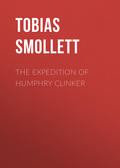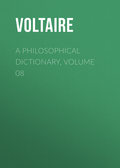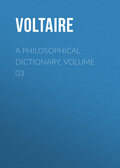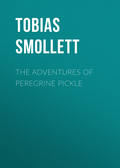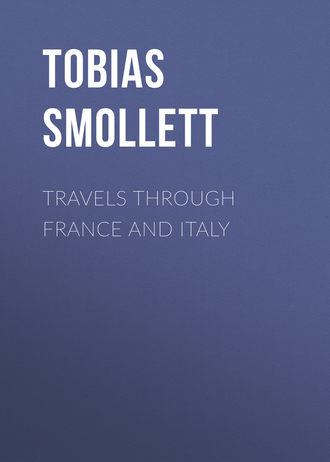
Tobias Smollett
Travels through France and Italy
LETTER XXXI
NICE, March 5, 1765
DEAR SIR,—In my last I gave you my opinion freely of the modern palaces of Italy. I shall now hazard my thoughts upon the gardens of this country, which the inhabitants extol with all the hyperboles of admiration and applause. I must acknowledge however, I have not seen the famous villas at Frascati and Tivoli, which are celebrated for their gardens and waterworks. I intended to visit these places; but was prevented by an unexpected change of weather, which deterred me from going to the country. On the last day of September the mountains of Palestrina were covered with snow; and the air became so cold at Rome, that I was forced to put on my winter cloaths. This objection continued, till I found it necessary to set out on my return to Florence. But I have seen the gardens of the Poggio Imperiale, and the Palazzo de Pitti at Florence, and those of the Vatican, of the pope's palace on Monte Cavallo, of the Villa Ludovisia, Medicea, and Pinciana, at Rome; so that I think I have some right to judge of the Italian taste in gardening. Among those I have mentioned, that of the Villa Pinciana, is the most remarkable, and the most extensive, including a space of three miles in circuit, hard by the walls of Rome, containing a variety of situations high and low, which favour all the natural embellishments one would expect to meet with in a garden, and exhibit a diversity of noble views of the city and adjacent country.
In a fine extensive garden or park, an Englishman expects to see a number of groves and glades, intermixed with an agreeable negligence, which seems to be the effect of nature and accident. He looks for shady walks encrusted with gravel; for open lawns covered with verdure as smooth as velvet, but much more lively and agreeable; for ponds, canals, basins, cascades, and running streams of water; for clumps of trees, woods, and wildernesses, cut into delightful alleys, perfumed with honeysuckle and sweet-briar, and resounding with the mingled melody of all the singing birds of heaven: he looks for plats of flowers in different parts to refresh the sense, and please the fancy; for arbours, grottos, hermitages, temples, and alcoves, to shelter him from the sun, and afford him means of contemplation and repose; and he expects to find the hedges, groves, and walks, and lawns kept with the utmost order and propriety. He who loves the beauties of simple nature, and the charms of neatness will seek for them in vain amidst the groves of Italy. In the garden of the Villa Pinciana, there is a plantation of four hundred pines, which the Italians view with rapture and admiration: there is likewise a long walk, of trees extending from the garden-gate to the palace; and plenty of shade, with alleys and hedges in different parts of the ground: but the groves are neglected; the walks are laid with nothing but common mould or sand, black and dusty; the hedges are tall, thin and shabby; the trees stunted; the open ground, brown and parched, has scarce any appearance of verdure. The flat, regular alleys of evergreens are cut into fantastic figures; the flower gardens embellished with thin cyphers and flourished figures in box, while the flowers grow in rows of earthen-pots, and the ground appears as dusky as if it was covered with the cinders of a blacksmith's forge. The water, of which there is great plenty, instead of being collected in large pieces, or conveyed in little rivulets and streams to refresh the thirsty soil, or managed so as to form agreeable cascades, is squirted from fountains in different parts of the garden, through tubes little bigger than common glyster-pipes. It must be owned indeed that the fountains have their merit in the way of sculpture and architecture; and that here is a great number of statues which merit attention: but they serve only to encumber the ground, and destroy that effect of rural simplicity, which our gardens are designed to produce. In a word, here we see a variety of walks and groves and fountains, a wood of four hundred pines, a paddock with a few meagre deer, a flower-garden, an aviary, a grotto, and a fish-pond; and in spite of all these particulars, it is, in my opinion, a very contemptible garden, when compared to that of Stowe in Buckinghamshire, or even to those of Kensington and Richmond. The Italians understand, because they study, the excellencies of art; but they have no idea of the beauties of nature. This Villa Pinciana, which belongs to the Borghese family, would make a complete academy for painting and sculpture, especially for the study of antient marbles; for, exclusive of the statues and busts in the garden, and the vast collection in the different apartments, almost the whole outside of the house is covered with curious pieces in basso and alto relievo. The most masterly is that of Curtius on horseback, leaping into the gulph or opening of the earth, which is said to have closed on receiving this sacrifice. Among the exhibitions of art within the house, I was much struck with a Bacchus, and the death of Meleager, represented on an antient sepulchre. There is also an admirable statue of Silenus, with the infant Bacchus in his arms; a most beautiful gladiator; a curious Moor of black marble, with a shirt of white alabaster; a finely proportioned bull of black marble also, standing upon a table of alabaster; a black gipsey with a head, hands, and feet of brass; and the famous hermaphrodite, which vies with that of Florence: though the most curious circumstance of this article, is the mattrass executed and placed by Bernini, with such art and dexterity, that to the view, it rivals the softness of wool, and seems to retain the marks of pressure, according to the figure of the superincumbent statue. Let us likewise own, for the honour of the moderns, that the same artist has produced two fine statues, which we find among the ornaments of this villa, namely, a David with his sling in the attitude of throwing the stone at the giant Goliah; and a Daphne changing into laurel at the approach of Apollo. On the base of this figure, are the two following elegant lines, written by pope Urban VIII. in his younger years.
Quisquis amans sequitur fugitivae gaudia formae,
Fronde manus implet, baccas vel carpit amaras.
Who pants for fleeting Beauty, vain pursuit!
Shall barren Leaves obtain, or bitter fruit.
I ought not to forget two exquisite antique statues of Venus, the weeping slave, and the youth pulling a thorn out of his foot.
I do not pretend to give a methodical detail of the curiosities of Rome: they have been already described by different authors, who were much better qualified than I am for the talk: but you shall have what observations I made on the most remarkable objects, without method, just as they occur to my remembrance; and I protest the remarks are all my own: so that if they deserve any commendation, I claim all the merit; and if they are impertinent, I must be contented to bear all the blame.
The piazza of St. Peter's church is altogether sublime. The double colonnade on each side extending in a semi-circular sweep, the stupendous Aegyptian obelisk, the two fountains, the portico, and the admirable facade of the church, form such an assemblage of magnificent objects, as cannot fail to impress the mind with awe and admiration: but the church would have produced a still greater effect, had it been detached entirely from the buildings of the Vatican, It would then have been a master-piece of architecture, complete in all its parts, intire and perfect: whereas, at present, it is no more than a beautiful member attached to a vast undigested and irregular pile of building. As to the architecture of this famous temple, I shall say nothing; neither do I pretend to describe the internal ornaments. The great picture of Mosaic work, and that of St. Peter's bark tossed by the tempest, which appear over the gate of the church, though rude in comparison with modern pieces, are nevertheless great curiosities, when considered as the work of Giotto, who flourished in the beginning of the fourteenth century. His master was Cimabue, who learned painting and architecture of the Grecian artists, who came from Constantinople, and first revived these arts in Italy. But, to return to St. Peter's, I was not at all pleased with the famous statue of the dead Christ in his mother's lap, by Michael Angelo. The figure of Christ is as much emaciated, as if he had died of a consumption: besides, there is something indelicate, not to say indecent, in the attitude and design of a man's body, stark naked, lying upon the knees of a woman. Here are some good pictures, I should rather say copies of good pictures, done in Mosaic to great perfection; particularly a St. Sebastian by Domenichino, and Michael the Archangel, from a painting of Guido Rheni. I am extremely fond of all this artist's pieces. There is a tenderness and delicacy in his manner; and his figures are all exquisitely beautiful, though his expression is often erroneous, and his attitudes are always affected and unnatural. In this very piece the archangel has all the air of a French dancing-master; and I have seen a Madonna by the same hand, I think it is in the Palazzo di Barberini, in which, though the figures are enchanting, the Virgin is represented holding up the drapery of the infant, with the ridiculous affectation of a singer on the stage of our Italian opera. The Mosaic work, though brought to a wonderful degree of improvement, and admirably calculated for churches, the dampness of which is pernicious to the colours of the pallet, I will not yet compare to the productions of the pencil. The glassyness (if I may be allowed the expression) of the surface, throws, in my opinion, a false light on some parts of the picture; and when you approach it, the joinings of the pieces look like so many cracks on painted canvas. Besides, this method is extremely tedious and expensive. I went to see the artists at work, in a house that stands near the church, where I was much pleased with the ingenuity of the process; and not a little surprized at the great number of different colours and tints, which are kept in separate drawers, marked with numbers as far as seventeen thousand. For a single head done in Mosaic, they asked me fifty zequines. But to return to the church. The altar of St. Peter's choir, notwithstanding all the ornaments which have been lavished upon it, is no more than a heap of puerile finery, better adapted to an Indian pagod, than to a temple built upon the principles of the Greek architecture. The four colossal figures that support the chair, are both clumsy and disproportioned. The drapery of statues, whether in brass or stone, when thrown into large masses, appears hard and unpleasant to the eye and for that reason the antients always imitated wet linen, which exhibiting the shape of the limbs underneath, and hanging in a multiplicity of wet folds, gives an air of lightness, softness, and ductility to the whole.
These two statues weigh 116,257 pounds, and as they sustain nothing but a chair, are out of all proportion, inasmuch as the supporters ought to be suitable to the things supported. Here are four giants holding up the old wooden chair of the apostle Peter, if we may believe the book De Identitate Cathedrae Romanae, Of the Identity of the Roman Chair. The implements of popish superstition; such as relicks of pretended saints, ill-proportioned spires and bellfreys, and the nauseous repetition of the figure of the cross, which is in itself a very mean and disagreeable object, only fit for the prisons of condemned criminals, have contributed to introduce a vitious taste into the external architecture, as well as in the internal ornaments of our temples. All churches are built in the figure of a cross, which effectually prevents the eye from taking in the scope of the building, either without side or within; consequently robs the edifice of its proper effect. The palace of the Escurial in Spain is laid out in the shape of a gridiron, because the convent was built in consequence of a vow to St. Laurence, who was broiled like a barbecued pig. What pity it is, that the labours of painting should have been so much employed on the shocking subjects of the martyrology. Besides numberless pictures of the flagellation, crucifixion, and descent from the cross, we have Judith with the head of Holofernes, Herodias with the head of John the Baptist, Jael assassinating Sisera in his sleep, Peter writhing on the cross, Stephen battered with stones, Sebastian stuck full of arrows, Laurence frying upon the coals, Bartholomew flaed alive, and a hundred other pictures equally frightful, which can only serve to fill the mind with gloomy ideas, and encourage a spirit of religious fanaticism, which has always been attended with mischievous consequences to the community where it reigned.
The tribune of the great altar, consisting of four wreathed brass pillars, gilt, supporting a canopy, is doubtless very magnificent, if not over-charged with sculpture, fluting, foliage, festoons, and figures of boys and angels, which, with the hundred and twenty-two lamps of silver, continually burning below, serve rather to dazzle the eyes, and kindle the devotion of the ignorant vulgar, than to excite the admiration of a judicious observer.
There is nothing, I believe, in this famous structure, so worthy of applause, as the admirable symmetry and proportion of its parts. Notwithstanding all the carving, gilding, basso relievos, medallions, urns, statues, columns, and pictures with which it abounds, it does not, on the whole, appear over-crouded with ornaments. When you first enter, your eye is filled so equally and regularly, that nothing appears stupendous; and the church seems considerably smaller than it really is. The statues of children, that support the founts of holy water when observed from the door, seem to be of the natural size; but as you draw near, you perceive they are gigantic. In the same manner, the figures of the doves, with olive branches in their beaks, which are represented on the wall, appear to be within your reach; but as you approach them, they recede to a considerable height, as if they had flown upwards to avoid being taken.
I was much disappointed at sight of the Pantheon, which, after all that has been said of it, looks like a huge cockpit, open at top. The portico which Agrippa added to the building, is undoubtedly very noble, though, in my opinion, it corresponds but ill with the simplicity of the edifice. With all my veneration for the antients, I cannot see in what the beauty of the rotunda consists. It is no more than a plain unpierced cylinder, or circular wall, with two fillets and a cornice, having a vaulted roof or cupola, open in the centre. I mean the original building, without considering the vestibule of Agrippa. Within side it has much the air of a mausoleum. It was this appearance which, in all probability, suggested the thought to Boniface IV. to transport hither eight and twenty cart-loads of old rotten bones, dug from different burying-places, and then dedicate it as a church to the blessed Virgin and all the holy martyrs. I am not one of those who think it is well lighted by the hole at the top, which is about nine and twenty feet in diameter, although the author of the Grand Tour calls it but nine. The same author says, there is a descent of eleven steps to go into it; that it is a hundred and forty-four feet in heighth, and as many in breadth; that it was covered with copper, which, with the brass nails of the portico, pope Urban VIII. took away, and converted into the four wreathed pillars that support the canopy of the high altar in the church of St. Peter, &c. The truth is, before the time of pope Alexander VII. the earth was so raised as to cover part of the temple, and there was a descent of some steps into the porch: but that pontiff ordered the ground to be pared away to the very pedestal or base of the portico, which is now even with the street, so that there is no descent whatsoever. The height is two hundred palmi, and the breadth two hundred and eighteen; which, reckoning fife palmi at nine inches, will bring the height to one hundred and fifty, and the breadth to one hundred and sixty-three feet six inches. It was not any covering of copper which pope Urban VIII. removed, but large brass beams, which supported the roof of the portico. They weighed 186,392 pounds; and afforded metal enough not only for the pillars in St. Peter's church, but also for several pieces of artillery that are now in the castle of St. Angelo. What is more extraordinary, the gilding of those columns is said to have cost forty thousand golden crowns: sure money was never worse laid out. Urban VIII. likewise added two bellfrey towers to the rotunda; and I wonder he did not cover the central hole with glass, as it must be very inconvenient and disagreeable to those who go to church below, to be exposed to the rain in wet weather, which must also render it very damp and unwholesome. I visited it several times, and each time it looked more and more gloomy and sepulchral.
The magnificence of the Romans was not so conspicuous in their temples, as in their theatres, amphitheatres, circusses, naumachia, aqueducts, triumphal arches, porticoes, basilicae, but especially their thermae, or bathing-places. A great number of their temples were small and inconsiderable; not one of them was comparable either for size or magnificence, to the modern church of St. Peter of the Vatican. The famous temple of Jupiter Capitolinus was neither half so long, nor half so broad: it was but two hundred feet in length, and one hundred and eighty-five in breadth; whereas the length of St. Peter's extends to six hundred and thirty-eight feet, and the breadth to above five hundred. It is very near twice as large as the temple of Jupiter Olympius in Greece, which was counted one of the seven wonders of the world. But I shall take another opportunity to explain myself further on the antiquities of this city; a subject, upon which I am disposed to be (perhaps impertinently) circumstantial. When I begin to run riot, you should cheek me with the freedom of a friend. The most distant hint will be sufficient to,—Dear Sir, Yours assuredly.
LETTER XXXII
NICE, March 10, 1765.
DEAR SIR,—The Colossaeum or amphitheatre built by Flavius Vespasian, is the most stupendous work of the kind which antiquity can produce. Near one half of the external circuit still remains, consisting of four tire of arcades, adorned with columns of four orders, Doric, Ionic, Corinthian, and Composite. The height and extent of it may be guessed from the number of spectators it contained, amounting to one hundred thousand; and yet, according to Fontana's mensuration, it could not contain above thirty-four thousand persons sitting, allowing a foot and an half for each person: for the circuit of the whole building did not exceed one thousand five hundred and sixty feet. The amphitheatre at Verona is one thousand two hundred and ninety feet in circumference; and that of Nismes, one thousand and eighty. The Colossaeum was built by Vespasian, who employed thirty thousand Jewish slaves in the work; but finished and dedicated by his son Titus, who, on the first day of its being opened, produced fifty thousand wild beasts, which were all killed in the arena. The Romans were undoubtedly a barbarous people, who delighted in horrible spectacles. They viewed with pleasure the dead bodies of criminals dragged through the streets, or thrown down the Scalae Gemoniae and Tarpeian rock, for their contemplation. Their rostra were generally adorned with the heads of some remarkable citizens, like Temple-Bar, at London. They even bore the sight of Tully's head fixed upon that very rostrum where he had so often ravished their ears with all the charms of eloquence, in pleading the cause of innocence and public virtue. They took delight in seeing their fellow-creatures torn in pieces by wild beasts, in the amphitheatre. They shouted with applause when they saw a poor dwarf or slave killed by his adversary; but their transports were altogether extravagant, when the devoted captives were obliged to fight in troops, till one side was entirely butchered by the other. Nero produced four hundred senators, and six hundred of the equestrian order, as gladiators in the public arena: even the women fought with wild beasts, as well as with each other, and drenched the amphitheatres with their blood. Tacitus says, "Sed faeminarum illustrium, senatorumque filiorum plures per arenam faedati sunt," "But many sons of Senators, and even Matrons of the first Rank, exposed themselves in this vile exercise." The execrable custom of sacrificing captives or slaves at the tombs of their masters and great men, which is still preserved among the negroes of Africa, obtained also among the antients, Greeks as well as Romans. I could never, without horror and indignation, read that passage in the twenty-third book of the Iliad, which describes twelve valiant Trojan captives sacrificed by the inhuman Achilles at the tomb of his friend Patroclus.
Dodeka men Troon megathumon uias eathlous
Tous ama pantas pur eathiei.
Twelve generous Trojans slaughtered in their Bloom,
With thy lov'd Corse the Fire shall now consume.
Even Virgil makes his pious Hero sacrifice eight Italian youths to the manes of Pallas. It is not at all clear to me, that a people is the more brave, the more they are accustomed to bloodshed in their public entertainments. True bravery is not savage but humane. Some of this sanguinary spirit is inherited by the inhabitants of a certain island that shall be nameless—but, mum for that. You will naturally suppose that the Coliseo was ruined by the barbarians who sacked the city of Rome: in effect, they robbed it of its ornaments and valuable materials; but it was reserved for the Goths and Vandals of modern Rome, to dismantle the edifice, and reduce it to its present ruinous condition. One part of it was demolished by pope Paul II. that he might employ the stones of it in building the palace of St. Mark. It was afterwards dilapidated for the same purposes, by the cardinals Riarius and Farnese, which last assumed the tiara under the name of Paul III. Notwithstanding these injuries, there is enough standing to convey a very sublime idea of ancient magnificence.
The Circi and Naumachia, if considered as buildings and artificial basins, are admirable; but if examined as areae intended for horse and chariot races, and artificial seas for exhibiting naval engagements, they seem to prove that the antient Romans were but indifferently skilled and exercised either in horsemanship or naval armaments. The inclosure of the emperor Caracalla's circus is still standing, and scarce affords breathing room for an English hunter. The Circus Maximus, by far the largest in Rome, was not so long as the Mall; and I will venture to affirm, that St. James's Park would make a much more ample and convenient scene for those diversions. I imagine an old Roman would be very much surprised to see an English race on the course at New-Market. The Circus Maximus was but three hundred yards in breadth. A good part of this was taken up by the spina, or middle space, adorned with temples, statues, and two great obelisks; as well as by the euripus, or canal, made by order of Julius Caesar, to contain crocodiles, and other aquatic animals, which were killed occasionally. This was so large, that Heliogabalus, having filled it with excellent wine, exhibited naval engagements in it, for the amusement of the people. It surrounded three sides of the square, so that the whole extent of the race did not much exceed an English mile; and when Probus was at the expence of filling the plain of it with fir-trees to form a wood for the chace of wild beasts, I question much if this forest was more extensive than the plantation in St. James's Park, on the south side of the canal: now I leave you to judge what ridicule a king of England would incur by converting this part of the park into a chace for any species of animals which are counted game in our country.
The Roman emperors seemed more disposed to elevate and surprize, than to conduct the public diversions according to the rules of reason and propriety. One would imagine, it was with this view they instituted their naumachia, or naval engagements, performed by half a dozen small gallies of a side in an artificial basin of fresh water. These gallies I suppose were not so large as common fishing-smacks, for they were moved by two, three, and four oars of a side according to their different rates, biremes, triremes, and quadriremes. I know this is a knotty point not yet determined; and that some antiquarians believe the Roman gallies had different tires or decks of oars; but this is a notion very ill supported, and quite contrary to all the figures of them that are preserved on antient coins and medals. Suetonius in the reign of Domitian, speaking of these naumachia, says, "Edidit navales pugnas, pene justarum classium, effosso, et circumducto juxta Tyberim lacu, atque inter maximas imbres prospectavit," "He exhibited naval engagements of almost intire fleets, in an artificial Lake formed for the purpose hard by the Tyber, and viewed them in the midst of excessive Rains." This artificial lake was not larger than the piece of water in Hyde-Park; and yet the historian says, it was almost large enough for real or intire fleets. How would a British sailor relish an advertisement that a mock engagement between two squadrons of men of war would be exhibited on such a day in the Serpentine river? or that the ships of the line taken from the enemy would be carried in procession from Hyde-Park-Corner to Tower-wharf? Certain it is, Lucullus, in one of his triumphs, had one hundred and ten ships of war (naves longas) carried through the streets of Rome. Nothing can give a more contemptible idea of their naval power, than this testimony of their historians, who declare that their seamen or mariners were formed by exercising small row-boats in an inclosed pool of fresh water. Had they not the sea within a few miles of them, and the river Tyber running through their capital! even this would have been much more proper for exercising their watermen, than a pond of still-water, not much larger than a cold-bath. I do believe in my conscience that half a dozen English frigates would have been able to defeat both the contending fleets at the famous battle of Actium, which has been so much celebrated in the annals of antiquity, as an event that decided the fate of empire.
It would employ me a whole month to describe the thermae or baths, the vast ruins of which are still to be seen within the walls of Rome, like the remains of so many separate citadels. The thermae Dioclesianae might be termed an august academy for the use and instruction of the Roman people. The pinacotheca of this building was a complete musaeum of all the curiosities of art and nature; and there were public schools for all the sciences. If I may judge by my eye, however, the thermae Antonianae built by Caracalla, were still more extensive and magnificent; they contained cells sufficient for two thousand three hundred persons to bathe at one time, without being seen by one another. They were adorned with all the charms of painting, architecture, and sculpture. The pipes for convoying the water were of silver. Many of the lavacra were of precious marble, illuminated by lamps of chrystal. Among the statues, were found the famous Toro, and Hercole Farnese.
Bathing was certainly necessary to health and cleanliness in a hot country like Italy, especially before the use of linen was known: but these purposes would have been much better answered by plunging into the Tyber, than by using the warm bath in the thermae, which became altogether a point of luxury borrowed from the effeminate Asiatics, and tended to debilitate the fibres already too much relaxed by the heat of the climate. True it is, they had baths of cool water for the summer: but in general they used it milk-warm, and often perfumed: they likewise indulged in vapour-baths, in order to enjoy a pleasing relaxation, which they likewise improved with odoriferous ointments.
The thermae consisted of a great variety of parts and conveniences; the natationes, or swimming places; the portici, where people amused themselves in walking, conversing, and disputing together, as Cicero says, In porticibus deambulantes disputabant; the basilicae, where the bathers assembled, before they entered, and after they came out of the bath; the atria, or ample courts, adorned with noble colonnades of Numidian marble and oriental granite; the ephibia, where the young men inured themselves to wrestling and other exercises; the frigidaria, or places kept cool by a constant draught of air, promoted by the disposition and number of the windows; the calidaria, where the water was warmed for the baths; the platanones, or delightful groves of sycamore; the stadia, for the performances of the athletae; the exedrae, or resting-places, provided with seats for those that were weary; the palestrae, where every one chose that exercise which pleased him best; the gymnasia, where poets, orators, and philosophers recited their works, and harangued for diversion; the eleotesia, where the fragrant oils and ointments were kept for the use of the bathers; and the conisteria, where the wrestlers were smeared with sand before they engaged. Of the thermae in Rome, some were mercenary, and some opened gratis. Marcus Agrippa, when he was edile, opened one hundred and seventy private baths, for the use of the people. In the public baths, where money was taken, each person paid a quadrans, about the value of our halfpenny, as Juvenal observes,
Caedere Sylvano porcum, quadrante lavari.
The victim Pig to God Sylvanus slay,
And for the public Bath a farthing pay.
But after the hour of bathing was past, it sometimes cost a great deal more, according to Martial,



